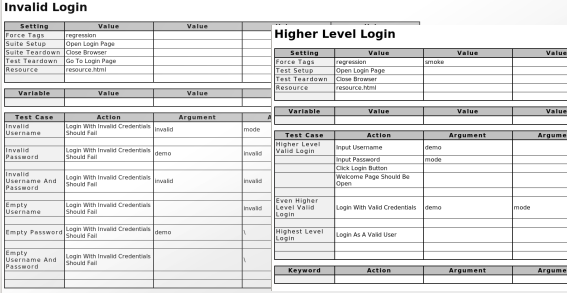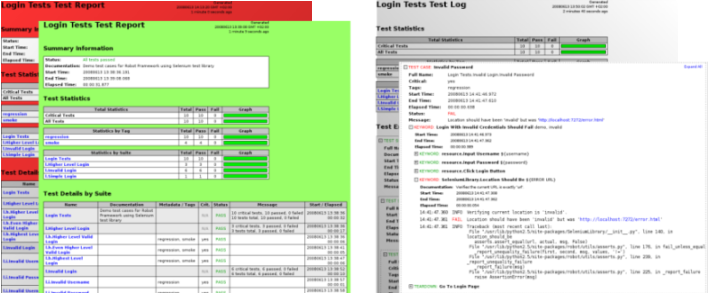1.1 Introduction
Robot Framework is a Python-based, extensible keyword-driven test automation framework for end-to-end acceptance testing and acceptance-test-driven development (ATDD). It can be used for testing distributed, heterogeneous applications, where verification requires touching several technologies and interfaces.
Robot Framework是一个基于Python的, 可扩展的关键字驱动的自动化测试框架, 用于端到端的验收测试和验收测试驱动开发(ATDD). 它可用于测试分布式的多样化的采用多种技术及接口的应用.
- 1.1.1 Why Robot Framework?
- 1.1.2 High-level architecture
- 1.1.3 Screenshots
- 1.1.4 Getting more information
1.1.1 Why Robot Framework?
- Enables easy-to-use tabular syntax for creating test cases in a uniform way.
可以用简单的表格式语法建立统一的Test Cases.
- Provides ability to create reusable higher-level keywords from the existing keywords.
可以用已有的Keywords构造可重用的高级Keywords功能.
提供HTML格式的Report和logs输出
- Is platform and application independent.
跨平台跨应用
- Provides a simple library API for creating customized test libraries which can be implemented natively with either Python or Java.
提供简单的Library API以创建自定义的原生Python and Java Libraries,
- Provides a command line interface and XML based output files for integration into existing build infrastructure (continuous integration systems).
提供命令行久界面及基于XML的output file, 以便于集成入已有的系统
- Provides support for Selenium for web testing, Java GUI testing, running processes, Telnet, SSH, and so on.
支持Selenium 网络测试, Java GUI测试, Running processes, Telnet, SSH, 等等
- Supports creating data-driven test cases.
支持创建data-driven test cases(数据驱动安全)
- Has built-in support for variables, practical particularly for testing in different environments.
- Provides tagging to categorize and select test cases to be executed.
- Enables easy integration with source control: test suites are just files and directories that can be versioned with the production code.
- Provides test-case and test-suite -level setup and teardown.
- The modular architecture supports creating tests even for applications with several diverse interfaces.
1.1.2 High-level architecture
Robot Framework is a generic, application and technology independent framework. It has a highly modular architecture illustrated in the diagram below.

Robot Framework architecture
The test data is in simple, easy-to-edit tabular format. When Robot Framework is started, it processes the test data, executes test cases and generates logs and reports. The core framework does not know anything about the target under test, and the interaction with it is handled by test libraries. Libraries can either use application interfaces directly or use lower level test tools as drivers.
1.1.3 Screenshots
Following screenshots show examples of the test data and created reports and logs.

Test case files

Reports and logs
1.1.4 Getting more information
Project pages
The number one place to find more information about Robot Framework and the rich ecosystem around it is http://robotframework.org. Robot Framework itself is hosted on GitHub.
Mailing lists
There are several Robot Framework mailing lists where to ask and search for more information. The mailing list archives are open for everyone (including the search engines) and everyone can also join these lists freely. Only list members can send mails, though, and to prevent spam new users are moderated which means that it might take a little time before your first message goes through. Do not be afraid to send question to mailing lists but remember How To Ask Questions The Smart Way.
General discussion about all Robot Framework related issues. Questions and problems can be sent to this list. Used also for information sharing for all users.
An announcements-only mailing list where only moderators can send messages. All announcements are sent also to the robotframework-users mailing list so there is no need to join both lists.
Discussion about Robot Framework development.
Automatically generated mails about commits to the version control system, build results, new and edited issues, and so on. Can be used to follow Robot Framework development.